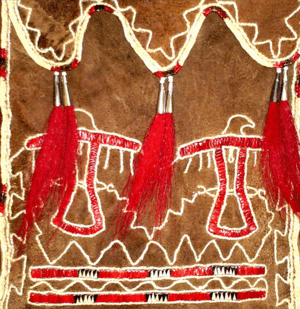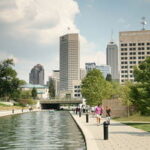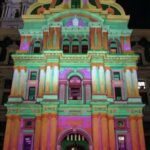Delaware or Lenape
Basics: Algonquian-speaking people. The Munsee-Delaware (Northern Delaware) were an extensive horticultural people who hunted and gathered, and lived in permanent year-round villages (wigwams and longhouses). The word “Delaware” is not a Native term. The Delaware were named such after the river many of their society resided on. The river was named after Sir Thomas West, Lord de la Warr (first governor of Virginia). Their name for themselves, Lenni-Lenape, roughly meaning “common people” or “real person” has dropped the Lenni in modern times. The Delaware or Lenape homelands upon European contact included all of New Jersey, Eastern Pennsylvania, Southern New York, coastal Delaware, and corners of Maryland and Connecticut. Some Delaware may have already passed through Indiana earlier than 1775 while headed to Missouri, and at least one Delaware village was established in Southern Indiana by 1776. However, most Delaware who came to reside within the state (on the White River) did so just years later coming from towns in Ohio where they resided in close proximity to the Miami and Shawnee (with the Shawnee in both Northern and Southern Indiana). By 1821, under American pressure, the Delaware had left Indiana for destinations in the states of Missouri, Kansas (later Oklahoma), Texas, and Wisconsin. There is also a slight possibility that some may have ended up in Mexico (see Kickapoo below).
Kickapoo
Basics: Algonquian-speaking horticultural people who hunted and gathered, and lived in permanent summer villages and structures (large bark houses: multifamily homes), and semi-permanent winter camps (wigwams: nuclear family homes).* The Kickapoo have one of the most unique “forced migration” histories of any Indiana tribe. Originally from Michigan (east of Lake Erie), they were met by Europeans in Wisconsin in the late 17th century. They lived in Indiana (on the Wabash River near Lafayette), Illinois and Missouri until the early 19th century when they moved to Kansas. Disillusioned by the government’s handling of their Kansas lands, the Kickapoo moved south in 1864 to Arkansas and then Texas (where they stayed with some Shawnee, Delaware, and Cherokee) before they were forced to move (this time by Texan settlements) to Oklahoma. However, some Kickapoo broke away and headed south instead to Mexico where it is believed that a few hundred Kickapoo still reside (about 400 in 1905).
Mahican
Basics: Algonquian-speaking people who were extensive horticulturalists who hunted and gathered, and lived in permanent year-round villages comprised of longhouses. The Mahican, sometimes spelled Mohican, are not the same people as the Mohegan (a completely different group in Southern New England, related to the Pequot). Mahican homelands upon European contact included Western Vermont, Massachusetts, Connecticut, and Eastern New York. Very few Mahicans came to live in Indiana (when compared to other Native communities represented) and those who did melded with the Delaware because they tended to live in the same villages with their old neighbors from the east (and share much the same culture as the Munsee-Delaware). As early as 1669 some Mahican had been exploring the Midwest. In 1721, part of the Mahican came to settle among the Miami on the Kankakee River (two bands of Mahican had been living among the Miami since 1680). In 1818, the Stockbridge (a branch of the Mahican) arrived on the White River, just in time to learn that the Delaware and Miami had sold those very lands. Many of the Stockbridge and some Delaware ended up moving to Wisconsin were their descendants still reside today known as the Stockbridge-Munsee.
Mascouten
Basics: Algonquian-speaking horticultural people who hunted and gathered, and lived in permanent summer villages and structures, and semi-permanent winter camps.* The Mascouten are placed in Michigan at the time of European contact, and in 1679 the Mascouten lived in areas all around the bottom of Lake Michigan including Northwestern Indiana. After 1735, many Mascouten lived with the Kickapoo, especially near Lafayette on the Wabash. By 1800, they seemed to have melded in with the Kickapoo who were vacating the Indiana-Illinois border by 1820. Unfortunately, the Mascouten may be arguably the least known tribe to have inhabited Indiana during the historic period which is why they have been under-represented in general publications and school text books.
Miami
Basics: Algonquian-speaking people who were extensive horticulturists. They also hunted and gathered foods. They lived in permanent summer villages and structures (possibly large bark houses: multifamily homes), and semi-permanent winter camps (wigwams: nuclear family homes).* Considered Indiana’s original people, the Miami (or Myaamia in the Miami language) were first met near Green Bay, Wisconsin as refugees from the Iroquois Wars. Compared to their Fox (Meskwaki) neighbors in Wisconsin, the Miami seemed “out of place,” and unable to deal with northern weather patterns that inhibited their hunting (as Miami seemingly made no snowshoes aboriginally). This was because the Miami probably didn’t practice deep snow hunting as their culture placed a great importance on horticulture and their Indiana homelands provided large harvests of crops to get them through deep snow seasons. Indeed, the Miami are noted for their miles and miles of cornfields that surrounded their villages during the historic period. By 1680, the Miami had began to filter back into their homelands of Indiana and Ohio. The Miami tribe included six major sub-groups: Atchatchakangouen, Kilatika, Mengakonkia, Pepikokia, Piankeshaw, and Wea. The Miami proper (excluding the Wea, Pepikokia, and Piankeshaw) inhabited central Indiana east into Ohio during the 18th century. The later three groups had separated into two distinct tribes and retained their status as such for the majority of the historic period (see Piankeshaw and Wea). The Miami proper was a constant presence in Indiana during the post-historic period. Most were removed by American troops in 1846 to Kansas, then Oklahoma where most still reside (Oklahoma Miami). Some Miami were able to resist or compel the United States to not remove them, and their descendants continue to live in Indiana today (Indiana Miami).
Nanticoke
Basics: Algonquian-speaking people who were extensive horticulturalists who also gathered (especially fishing and clamming) and hunted. They lived in villages comprised of multifamily longhouses. The Nanticoke homelands encompassed Eastern Maryland, Western Delaware, and a small corner of Virginia. Like other tribes of the east, the Nanticoke experience in the historic period included necessary migrations away from encroaching white settlements. When last holdouts in Maryland were threatened, they removed to Pennsylvania, usually living among other refugee Native groups, especially the Delaware. Later many Nanticoke moved up to New York to live with the Iroquois, but a faction went west with the Delaware. By 1805, this Nanticoke community established a village on the White River in Indiana, and by 1818, they removed west of the Mississippi, where they resided in Kansas for a period before ending up in Oklahoma.
Ojibwa or Chippewa
Basics: Algonquian-speaking hunters and gatherers (especially wild rice and fish), who also gardened (depending on their location for full growing seasons to cultivate corn). They resided in seasonal villages and camps comprised of multi-family homes and single family homes (dome, conical, and a-frame wigwams) – those who farmed lived in summer villages. The southern Ojibwa homelands most probably extended from the Georgian Bay, west along the north shore of Lake Huron, to the Upper Peninsula of Michigan. With the Huron (many of whom became Wyandot) being routed in the mid 17th century by the Iroquois, the Iroquois then began putting pressure on the Ojibwa. Since then, conflict and the fur trade had encouraged the movement of many Ojibwa communities all over the Great Lakes stage, including south to Ohio and Indiana. Some had come to reside for a time in Prophetstown in the early 1800’s. While most tribes of the region were removed west of the Mississippi, most Ojibwa have remained in the Great Lakes region until present – their higher populations can be found in Minnesota, Wisconsin, Michigan, and adjacent areas in Canada. By 1970, about half of the Ojibwa population resided in urban centers.
Ottawa or Odawa
Basics: Algonquian-speaking fishing people who hunted, gathered, and cultivated crops. They lived in permanent villages comprised of longhouses, and utilized conical wigwams on hunting and fishing trips. At the time of European contact, the Ottawa were located in Manitoulin Island and the adjacent Bruce Peninsula (lands and shores just northeast of Lower Michigan on the other side of Lake Huron). They moved around and expanded their areas into more Canadian county, Ohio, Michigan, Illinois, Wisconsin, and small sections of Indiana’s borders with Michigan and Ohio during the historic period (up to 1839). Groups of Ottawa (Odawa) and closely related Chippewa (Ojibwa) also took up residence in Prophetstown (in Battle Ground near Lafayette, 1808-1811), however, most left after one severe winter (some Ottawa returned later). Today, larger Ottawa populations reside in Ontario, Michigan, and Oklahoma.
Piankeshaw
Basics: Algonquian-speaking extensive horticulturists who hunted and gathered. They lived in permanent summer villages and structures (possibly large bark houses: multifamily homes), and semi-permanent winter camps (wigwams: nuclear family homes).* The Piankeshaw are a faction of the Miami, who separated and maintained separate tribal status in the historic period (until 1854 when they formally joined some Illinois and the Wea, creating the Confederated Peoria). The Piankeshaw, like their Miami cousins, were the original people of Indiana. From 1725 they inhabited Southwestern Indiana and part of Southeastern Illinois until 1814 when they removed to Missouri in response to white expansion and pressure. Today, the Piankeshaw are no longer a separate entity, and Piankeshaw descendants are considered a part of the Peoria, one of the Illinois groups they merged with in the 19th century.
Potawatomi
Basics: Algonquian-speaking horticultural people who hunted and gathered, and lived in permanent summer villages and structures (large bark houses: multifamily homes), and probably dispersed into semi-permanent winter camps (dome wigwams: nuclear family homes).* Potawatomi homelands were situated in the southwestern quadrant of Lower Michigan (which might have possibly dipped into northwestern Indiana). By 1701, the Potawatomi had established a village on the Indiana-Michigan border. By 1768, Potawatomi residence had expanded to include the whole northern border of Indiana and by 1810, they established villages further south along the Wabash River. In 1830, the Potawatomi had several villages in Northern Indiana including on the Eel, Tippecanoe, and Wabash Rivers. The 1838 removal of the Potawatomi in northern Indiana to designated areas west of the Mississippi became famously known to modern Indianans as the “Trail of Death” (not to be confused with the “Trail of Tears” – referring to the Cherokee and Southeastern Indian removal journey – although they were all carried out under the same Indian Removal Act). These Potawatomi communities were eventually removed to Kansas and Oklahoma, where many still reside today. Some Potawatomi had also removed to Ontario between 1837 and 1840, where they are usually counted with the Canadian Chippewa and Ottawa communities today. Some Potawatomi remained in Indiana and Michigan, and their descendants continue to reside within the two states.
Shawnee
Basics: Algonquian-speaking, horticultural people who hunted and gathered, and lived in permanent summer villages and structures (large bark houses: multifamily homes), and semi-permanent winter camps (dome wigwams: nuclear family homes).* The Shawnee homelands are usually thought to be southern Ohio and adjacent areas in West Virginia and Kentucky (possibly associated or directly descended from the Fort Ancient complex). They are known for their extensive movements during the historic period (pre-removal), inhabiting at one point the states (east of the Mississippi) of Pennsylvania, Ohio, Indiana, Illinois, Maryland, Kentucky, Tennessee, and even Georgia and Alabama. Shawnee villages were built in southeastern Indiana along the Ohio River by 1670. By 1788, the Shawnee established villages on the lower White River and near the Miami and Delaware near Fort Wayne. They continue to establish villages throughout Indiana, but especially in the southern half of the state (with Delaware towns along the Ohio River and near Beck’s Mill in Salem), until a small portion of Ohio Shawnee founded Prophetstown in 1808 (in Battle Ground near Lafayette). Prophetstown, while founded by the Shawnee renegade war leader Tecumseh and his brother The Prophet, was not a Shawnee “tribal” village. It was a pan-Indian village for believers of any Indian nation, and most Native Americans of the time did not agree with or support the village or brothers and their movement. However, it was the establishment of Prophetstown that would in fact attract some sympathizing Winnebago from Wisconsin to live in Indiana for a short period (see Winnebago). After the credibility of The Prophet was destroyed at the Battle of Tippecanoe in 1811, Tecumseh’s Shawnee followers went with him to Ontario but later ended up in Kansas.
Wea
Basics: Algonquian-speaking extensive horticulturalists who hunted and gathered. They lived in permanent summer villages and structures (possibly large bark houses: multifamily homes), and semi-permanent winter camps (wigwams: nuclear family homes).* The Wea (and the Miami sub-group Pepikokia who were probably absorbed by the Wea in about 1742) are a faction of the Miami, who separated and maintained separate tribal status in the historic period until 1854 when they formally joined some Illinois and the Piankeshaw, creating the Confederated Peoria. The Wea, like their Miami cousins, were the original people of Indiana. From 1700 they inhabited west-central Indiana and part of eastern Illinois until 1820 when they removed to Missouri in response to white expansion and pressure. Today, the removed Wea are no longer a separate entity, and removed Wea descendants are considered a part of the Peoria, one of the Illinois groups they merged with in the 19th century. There does however exist individuals of Wea heritage who have re-identified as a community along the Indiana-Illinois border.
Winnebago or Ho-Chunk
Basics: Siouan speaking horticulturalists who hunted and gathered. They lived in large, rectangular bark structures in their summer villages, while also utilizing dome wigwams (presumably during winter), which soon replaced the larger structures as the preferred year-round dwelling during the historic period.* The Winnebago homelands were located in the lower half of Wisconsin and on the northern Illinois border. During the span of Prophetstown, some Winnebago came to live there as believers, supporters, and fighters (some of Tecumseh’s warriors included Winnebago men). The population of Winnebago people at Prophetstown may have led to some of today’s misunderstandings of “Sioux” people from the “west” in Indiana, which then led many to believe that Plains peoples with tepees were in Indiana. The accounts are actually speaking of the Winnebago who are Siouan and from the Old Northwest – they were not Plains people who lived in tepees. The Winnebago are a part of the Northeastern cultural area and led the lifestyle of such; they lived in large bark houses and dome wigwams like their Woodland Indian neighbors. Removal for the Winnebago included residency in the states of Minnesota, Iowa, South Dakota, and Nebraska (Nebraska Winnebago), although a faction remained in Wisconsin (Wisconsin Winnebago).
Wyandot (Refugee Huron
& Tionantati/Petún)
Basics: Iroquoian-speakers were extensive horticulturalists who hunted and gathered (especially fishing). They lived in permanent year-round villages comprised of multifamily longhouses. This most likely gave way to smaller homes (wigwams) while fleeing war during historic times. The term Wyandot, for historians, is not just another word for the Huron tribe, as popularly believed. It is a Huron word (“Wendat”) that is applied by historians to a faction of Hurons and refugee Iroquoian peoples (including the Tionontati or Petún and possibly some Erie) who went to Detroit in 1701, and their community thereafter. While the French referred to the tribe as “Huron,” this refugee faction was known to the British as the “Wyandot.” The Wyandot made their way from their Huron and Iroquoian homelands in the eastern Great Lakes to the western Great Lakes while fleeing the Iroquois Five Nations (Haudenosaunee) during the “Iroquois Wars” (1641-1701). By 1811, a Wyandot village was established in Indiana by Prophetstown, where an area of pro-British Indian peoples were residing during the War of 1812 (other Wyandot were located in Ohio and Michigan at this time). Their influence probably reached farther than this single village in the northern part of the state, as legends of their residence and refugee hideouts in southern Indiana gave way to naming natural features in the state (like forests and caves) after the Wyandot.
Visitors to Indiana
Unquestionably, there were individuals of other tribal backgrounds who visited Indiana Indian towns for formalities and politics, or came to live individually as members of tribes established in Indiana, melding into the larger communities. One such example was the couple dozen Creek men who came to Prophetstown after being invited by Tecumseh to become part of the pan-Indian movement to resist American expansion. Some Meskwaki (Fox) also came to stay for a couple weeks at Prophetstown. Native people of other tribal backgrounds would have passed through Indiana to their destinations either east or west of the state. Especially “high traffic” areas for this would have been the bottom shores of Lake Michigan, south in the state along the Ohio River, and along interior rivers like the Wabash and Maumee Rivers that with one portage, travelers were connected to the Ohio and Mississippi Rivers to the south and west, and Lake Erie to the northeast.
*Terms in Context
Permanent village and structures – villages and bark-covered homes lasting 10 or more years in one location before a settlement is moved.
Semi-permanent winter camps and wigwams – camps used for 2-3 months and returned to year after year; the structure framework was always permanent (ex. dome wigwam frames are permanently secured in the ground and never moved, but the cattail mat coverings may be removed and taken away, then placed back on when returning next winter).
Note About Native Camps: All Native people of Indiana, whether they resided in their village year-round or most of the year, did take family trips to fishing and/or hunting and/or maple sugar camps. Their time spent at these locations amounted to anywhere from 4 to 7 weeks a year (excluding winter residences). After spending a couple weeks at a camp, they returned home to their village. This is not a nomadic lifestyle, nor “living” at temporary camps. These camps can be thought of in the same way one would think of a vacation home or hunting cabin: the destination a family may return to each year for a couple weeks or so at a time, with most of their belongings staying at home, not coming on the trip. If we do not think of this as “living on the move,” then we should not apply it to the Native people who did the same.
Sources:
“Atlas of Great Lakes Indian History” Edited by Helen Hornbeck Tanner
Handbook of the North American Indian.” Volume 15 – Northeast






